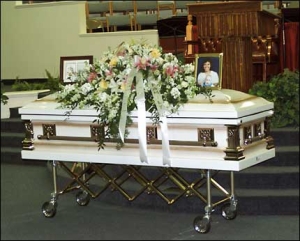影片对白 You're watching a football game at a
funeral?
考考你 一展身手
3. set someone up with
单身又想赶快找到另一半的人一定要把这个片语学起来,set someone up with 的意思就是“把……介绍给……”。片段中的这句话 The
point is, if you were gonna set me up with someone, I'd like to think you'd set
me up with someone like him. 意思就是:我的意思是,如果你想给我介绍对象的话,我希望你会介绍他。
我们来看个例子:Why is everyone trying to set me up on a date? 为什么每个人都想给我介绍对象呢?
4. out of one's league
Out of one's league的意思是“与……不属同一类型”。电影中这句话的意思就是:Well, I think Brian's a little
out of your league. 喔,我认为你有点攀不上布赖恩。
再比如:Dude, she is so out of your league. 哥们,你跟她相比太悬殊了。
5. go with
Go with的本意是“与……意见一致”,这里指“选择”:We'll go with the burgundy.
我们就选紫红色。比如:Go
with your gut, especially when shopping, for study finds that purchases based on
emotion are more satisfying in the long term.
购物时尤其要听从你的直觉,因为研究表明顺着心情买的东西从长期来看更让人满意。
6. dress up
Dress up
的意思是“精心打扮”。在西方社会,要参加正式的场合都要打扮起来,穿上正式些的服装。比如:With the party organizer urging
everyone to dress up to their fullest, people will be letting their hair down
and going crazy as only a Halloween crowd can.
派对主办者要求每个人尽量打扮,由此大家将会放下头发,像万圣节的人群一样疯狂。
文化面面观
Traditional
Funerals in contemporary North America
Visitation
At the
visitation (also called a "viewing" or "wake") the embalmed body of the deceased
person (or decedent) is placed on display in the coffin (also called a casket).
The viewing often takes place on one or two evenings before the funeral.
In addition, a family may choose to display photographs taken of the deceased
person during his/her life (often, formal portraits with other family members
and candid pictures to show "happy times"), prized possessions and other items
representing his/her hobbies and/or accomplishments.
 The viewing is either "open casket", in which the
embalmed body of the deceased has been clothed and treated with cosmetics for
display; or "closed casket", in which the coffin is closed.
The viewing is either "open casket", in which the
embalmed body of the deceased has been clothed and treated with cosmetics for
display; or "closed casket", in which the coffin is closed.
The viewing typically takes place at a funeral home. It may also take place
at a church.
Funeral
A memorial
service, often officiated by clergy from the decedent's or bereaved's church or
religion. A funeral may take place at either a funeral home or church. A funeral
is usually held three to five days after the death of the deceased.
Funeral services include prayers; readings from the Bible or other sacred
texts; hymns (sung either by the attendees or a hired vocalist); and words of
comfort by the clergy. Frequently, a relative or close friend will be asked to
give a eulogy, which details happy memories and accomplishments; often
commenting on the deceased's flaws, especially at length, is considered
impolite. Sometimes the delivering of the eulogy is done by the clergy.
Tradition also allows the attendees of the memorial service to have one last
opportunity to view the decedent's body and say good-bye; the immediate family
(siblings (and their spouses); followed by the decedent's spouse, parents and
children) are always the very last to view their loved one before the coffin is
closed. This opportunity can take place immediately before the service begins,
or at the very end of the service. During funerals, bagpipes are sometimes
played.
During the funeral and at the burial service, the casket may be covered with
a large arrangement of flowers, called a casket spray. If the decedent served in
a branch of the Armed forces, the casket may be covered with an American flag.
It is considered inappropriate to use both.
Burial service
Sometimes,
the burial service will immediately follow the funeral, in which case a funeral
procession (the hearse, followed by the immediate family and then the other
attendees) travels from the site of the memorial service to the burial site.
Other times, the burial service takes place at a later time, when the final
resting place is ready.
If the decedent served in a branch of the Armed forces, military rites are
often accorded at the burial service.
In many religious traditions, pallbearers, usually males who are close, but
not immediate relatives (such as cousins, nephews or grandchildren) or friends
of the decedent, will carry the casket from the chapel (of a funeral home or
church) to the hearse, and from the hearse to the site of the burial service.
The pallbearers often sit in a special reserved section during the memorial
service.